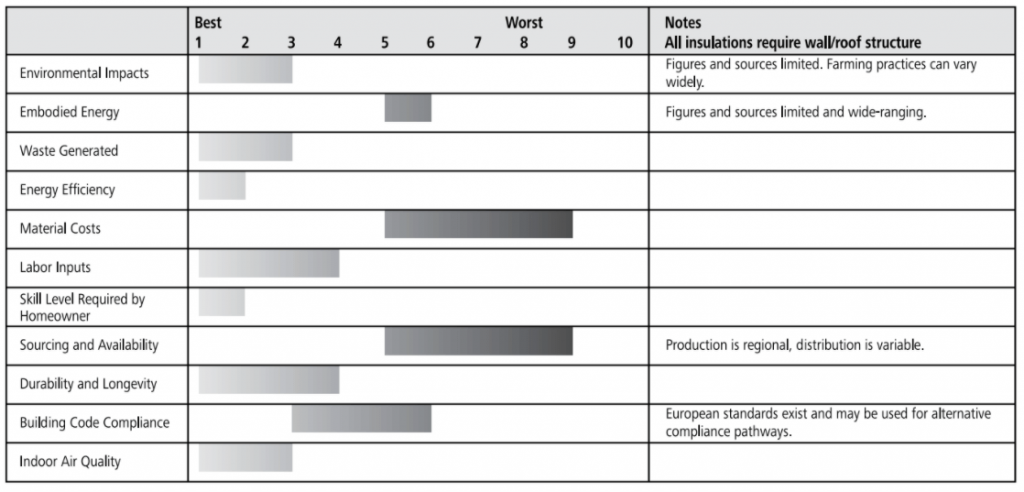Wool Batt
Insulation: MATERIALS ENCYcLOPEDIA
Applications for this system
Wall and roof insulation
Basic materials
Sheep’s wool
Poly fibers (in some products)
Ratings Chart for Wool batt insulation

The ratings chart shows comparative performance in each criteria category. Click on the tabs below for detailed analysis of each criteria.
- HOW THE SYSTEM WORKS
- ENVIRONMENTAL IMPACTS
- WASTE
- EMBODIED CARBON
- ENERGY EFFICIENCY
- MATERIAL COSTS
- LABOUR INPUT
- SKILL LEVEL REQUIRED
- SOURCING & AVAILABILITY
- DURABILITY
- CODE COMPLIANCE
- INDOOR AIR QUALITY
- RESOURCES
- FUTURE DEVELOPMENT
wool batt System
Sheep’s wool fibers are formed into batts or rolls in standard dimensions. Some wool insulation is held together mechanically (by interweaving of the fibers) while others use polyester strands interwoven with the wool. It is installed like any other batt product.
Environmental Impact Rating
Harvesting — Low to Moderate
The raising of sheep can have varying environmental impacts, usually as a result of overgrazing. However, responsible farming techniques can create positive effects from grazing. Some wool insulation companies offer information on their wool sources, and this would be useful if trying to ensure minimal impacts. Most wool batts are made from fiber that would otherwise be considered waste.
Some wool manufacturers use a high percentage of recycled wool. Sometimes this is post-consumer material or material recycled from manufacturer waste.
Manufacturing — Low to Moderate
Relatively low-impact mechanical processes are used to form the batts. A lot of water can be used to wash the wool; check with manufacturers to see if water recycling is used.
Transportation — Low to High
Sample building uses 825 kg of wool batt:
1.2 MJ per km by 15 ton truck
0.78 MJ per km by 35 ton truck
0.13 MJ per km by ocean freighter
Production is limited in North America, and many brands are imported from Europe. Impacts accrue proportional with distance traveled, though the material is lightweight.
Installation — Negligible
Waste: Low
Biodegradable/Compostable — Pure wool products.
Recyclable — Plastic packaging.
Landfill — Insulation offcuts. Certain wool insulations are spun with polyester fiber. Polyester content discounts claims that the wool insulation is biodegradable at the end of its useful life.
Chart of Embodied energy & carbon
Energy Efficiency: high
R-value: 3.2–3.9 per inch
All wool insulation requires an air control layer on both sides of the insulation. Gaps and voids in the insulation due to improper installation will lower the thermal performance.
The ability of wool fibers to absorb a great deal of moisture without losing insulation value means that real-world performance may be better than insulations that work best dry.
Material costs: high
Limited production and market penetration result in high costs. Quantity of raw material and ease of production could result in lower costs if additional production facilities are developed.
Labour Input: low to moderate
The installation of sheep’s wool products is similar to that of any batt or board style of insulation.
Skill level required for homeowners: easy
Batt and board insulation can be successfully installed with very little experience, as long as care is taken to ensure tight fits in all cavities and to avoid voids or gaps.
Sourcing & availability: moderate to Difficult
Wool insulation is not readily available from conventional building supply outlets. There is some manufacturing capacity in North America, but most orders will need to be placed directly with the manufacturer. A high percentage of wool insulation is imported from the UK and Europe.
Durability: moderate to High
Wool batts should have a lifespan similar to other batt insulations. Insects (moths, in particular) can eat the wool insulation. The wool is typically treated with borax or other additives to discourage insect activity. The use of wool insulation in Europe for several decades indicates that durability issues are not problematic.
Code compliance
Wool insulation is not recognized in most building codes. Many manufacturers have undertaken the testing required showing code equivalency, and the use of tested material should not be problematic in most jurisdictions.
Indoor air quality: high
The ability of wool fibers to absorb a great deal of moisture without damage helps to keep wall cavities dry and prevent mold growth.
Wool is naturally nontoxic, but caution should be taken to research the nature of any insect or fire retardants added to the wool, which will vary by manufacturer.
Resources for further research
N/A
Future development
Wool insulation has enough advantages to drive up its market share as green building becomes more popular. The use of batt insulation is a conventional practice and it will be easy for builders to switch to healthier batts as they become available. Manufacturing capacity will need to increase greatly, and the speed at which capacity grows will be dependent on market uptake of wool batts.
Tips for successful wool batt insulation
1. Batt insulations require careful installation to prevent gaps and voids.
2. An effective air control layer must be used with batt insulations.




